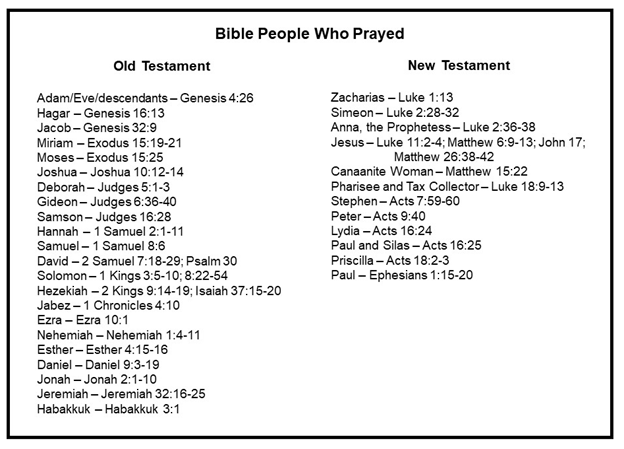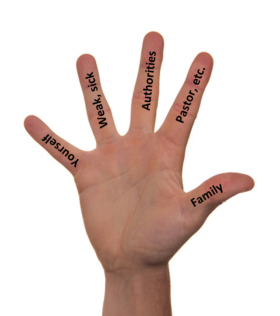Teaching Your Student to Pray

"I call upon You, for You will answer me, O God; incline Your ear to me; hear my words.” – Psalm 17:6
“Do not be anxious about anything, but in everything by prayer and supplication with thanksgiving let your requests be made known to God.” – Philippians 4:6
“Pray without ceasing.” – 1 Thessalonians 5:17
Amy Carmichael was born December 16, 1867, in Belfast, Ireland. Her parents were devout Christians who loved the Lord and taught their children to know and follow Him. When Amy was a young girl, she wanted blue eyes instead of her brown eyes. She had been taught to pray that she could ask God for things and that He would answer prayer. So, Amy prayed and asked God to give her blue eyes like her mother’s and like the Irish sea. The next day when she looked in the mirror, brown eyes stared back at her, and she was deeply disappointed that God had not answered her prayer. But He had, and His answer was “no.” Amy would need those brown eyes when she went to India as a missionary years later. There, she saw how children were given to the temples, and her heart went out to them. God led her to rescue many. Amy learned to rub dark coffee on her light skin to blend in with the brown skinned Indian people, but she didn’t have to do anything about her eye color because they were already brown. Amy realized then that God had answered her childish prayer, and she thanked God for not giving her blue eyes so that she could help the children of India.
What is Prayer?
Prayer is simply talking to God, person to person. The Bible tells us a lot about prayer. In fact, there are 650 prayers in the Bible and 450 recorded answers! In addition, the Scriptures tell us to pray 400 times. So, let’s look in the Bible to learn about prayer.
What Should Children know about Prayer?

1. God wants believers to pray for all people.
Paul instructed Timothy to pray for “all people”: “First of all, then I urge that supplications, prayers, intercessions, and thanksgivings be made for all people.” (1 Timothy 2:1) And, in his letter to the church in Ephesus, Paul encouraged the believers to pray for the “saints”: “praying at all times in the Spirit, with all prayer and supplication…making supplication for all the saints.” (Ephesians 6:19)
2. People prayed to God throughout the Bible.
Throughout the Old and New Testaments is story after story of people who prayed for various situations or needs. The following chart lists many who prayed in Bible times. Your children should be familiar with these individuals. You may choose to teach a series of lessons on prayer emphasizing their prayers and God’s answers.

It is said in historical writings about James, the brother of Jesus, (the author of the New Testament book of James), that he was frequently found in the temple in Jerusalem on his knees praying to God for people and for their forgiveness. He prayed so much in this position that his knees became hardened like those of a camel. James has been called the man with the camel knees. His body showed his deep commitment to prayer.
3. Christians have prayed throughout history. Some individuals who are known for their praying are:
• Praying Hyde – John Hyde was a missionary to India who prayed daily for souls to be saved. He prayed to lead one person a day to the Lord, and God answered his prayers. Then he prayed for two souls a day. (Visualized story about Praying Hyde available from: www.biblevisuals.org.)
• Amy Carmichael – A missionary to India, was known for her praying. (Visualized story about Amy Carmichael called “I Dare” available from: https://cefpress.com/curriculum/mission-lessons/)
• George Mueller – Founder of an orphanage in Bristol, England, who chose to ask only God to supply the needs of the orphanage. (Visualized story about George Mueller available from: www.biblevisuals.org.)
• Hudson Taylor – A missionary to China who determined to “only ask God” to supply his needs and those of the mission he began (China Inland Mission, now Overseas Missionary Fellowship). (Visualized story about Hudson Taylor available from: https://cefpress.com/curriculum/mission-lessons/)
4. There are different kinds of prayer
The Bible describes different kinds of prayers. As mentioned earlier, Paul urged “that supplications, prayers, intercessions, and thanksgivings be made for all people.” (1 Timothy 2:1) The following definitions will help your students understand what these terms mean:
• Supplications – a request or asking God for something for yourself
• Prayers – a general term that covers requesting help for oneself or others, or expressing thanks to God
• Intercession – praying for others
• Thanksgiving – thanking God when one’s prayer has been answered
• Petition – a request or asking God for something for someone else
Psalm 145 is David’s psalm of praise. Praise is another kind of prayer. In verses 1 and 2, he uses three words to address God: “I will extol you, my God and King, and bless your name forever and ever. Every day I will bless you and praise your name forever and ever.”
• Extol – praise enthusiastically
• Bless – honor, exalt, adore, worship
• Praise – show admiration for what someone has done
As you teach each word, give an example from the Bible or your own experience.
ACTS, an acrostic of four kinds of prayer. A good way to help children understand what they should pray to God is to use a simple acrostic like the following.


How Can You Teach Children to Pray?
1. Model prayer. Children “catch” what they see and hear. So pray the different kinds of prayer as they relate to your lesson, and kids will learn what to say. This is probably one of the best ways to teach about prayer.
2. Teach children how to address God in prayer. Explain that when we pray to God, we show Him how much we love or reverence Him by what we call Him in prayer. It is appropriate to address God as “Dear Heavenly Father,” “Dear God,” Dear Father in Heaven.”
3. Teach prayer through Bible stories/lessons. Visualized lessons are available from: www.biblevisuals.org; www.cefpress.com. Check www.christianbook.com for curricula and resources about prayer.
4. Teach prayer through songs. Music is an excellent method of teaching. The following are a few songs used to teach children about prayer. Google them on the internet for lyrics and music. "Whisper a Prayer in the Morning" (noon, evening); "The Lord’s Prayer"; "Read Your Bible, Pray Everyday"; "The Lord’s My Shepherd" (Psalm 23); and "What a Friend We Have in Jesus". Visualized songs available from Bible Visuals International (www.biblevisuals.org): "A Student’s Prayer"; "Guide Me, O Thou Great Jehovah"; and "Take My Life and Let it Be". Visualized song available from Child Evangelism Fellowship (cefpress.com): "Did You Ever Talk to God Above?"

Photo by Barbara Olsen
5. Teach the How, When, and Where of prayer. The Bible shows men and women praying in different ways: some stand, some kneel, some stretch out face down on the ground, some sit, some hold up their hands, and some bow their heads. Today, most people sit, stand, or kneel if they are able when they pray, and, almost always, they pray with their eyes closed. But you can pray with your eyes open, especially if you are driving a car while praying, or if you are in a difficult situation where you need to see what is happening. People in the Bible also prayed at different times of the day; there is no one time to pray. God is always ready to hear us when we talk to Him. People can pray anywhere: in church, in the home, at work or school, outdoors, in the car/train/plane/bus. On land, on the water, under the water (think Jonah!). You can pray anywhere!
6. Teach Bible verses about prayer through teaching a memory verse about prayer. Always clearly explain the meaning of the verse you are using. Use memory methods to help children retain what was taught:
- Hold a Bible drill with verses about prayer.
- Put the words of the memory verse to music using a familiar melody.
- Ask the students to illustrate the verse using stick figures or symbols.
- Tell a story incorporating the memory verse and illustrate it in comic book fashion with different blocks of pictures and speech bubbles.
- Learn sign language motions and teach the verse so that it can be recited “silently” with only the hands moving, not mouths.
- Divide the verse into phrases and divide the class into an equal number of groups with each group assigned a phrase which is then said by each group in order of the verse.
- “Ping pong” the verse by saying one word and pointing to a student who says the next word and then points to another student and so on. There are many Bible verses on prayer that can be taught, but you may want to try the verses in the following chart.

7. A Potpourri of methods to teach prayer.
- “Parrot” prayers – repeat a prayer after the teacher, helpful for young children.
- “Fill-in-the-Blank prayers – “I am grateful for ____________.” “Help ________.” “I love You because ___________.”
- “Point to” prayers – point to a picture, then pray for what was chosen. Useful for young children. Pictures can be people, animals, things (food, plants, etc.).
- "Sentence” prayers – explain that the students prayers are to be short, just one sentence. Best for “Thank You” or praise prayers.
- “Group” prayers – divide children into small groups; give each group one request for prayer; and encourage all to participate in praying. Or pray together as an entire class.
- “Unison” prayers – when teaching the Lord’s Prayer, recite together as a class.
- “Written” prayers – these can be written in class or at home in a prayer journal.

- “Hand” prayer – use the hand as a visual reminder of what we should pray for: thumb (those nearest to us like our family); pointer finger (those who point others to Jesus—pastor, missionaries, Sunday school teachers); highest finger (those in authority—mayors, governors, president, police); ring finger (weakest finger—those who are weak/sick); and the pinky finger (yourself).
- “Silent” prayers – there may be times when it is appropriate to ask the children to pray silently.

• “Traffic Light” prayer – a visual reminder of how God answers our prayers:
Red = “No, God knows it’s not best to answer your prayer.”
Yellow = “Wait, it’s not time for your prayer to be answered.”
Green = “Yes, God wants to answer your prayer now.”
• THUMB prayer – this acronym will remind children to pray for the Tribal, Hindu, Unreached, Muslim, and Buddhist people to hear the Gospel and believe in Jesus. Google THUMB acronym or go to https://www.missiontools.org/resources/thumb/.
• “Celebrate” answers to prayer – record students’ requests, and ask students to report when their prayers are answered.
Remind children:
“Don’t worry about having the right words; worry about having the right heart. It’s not eloquence God seeks, just honesty.” – Max Lucado




